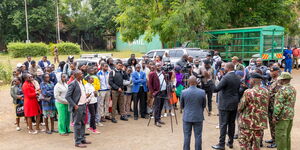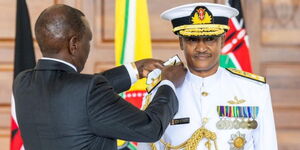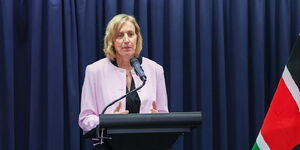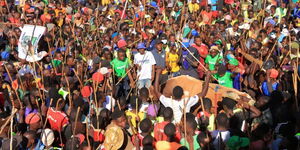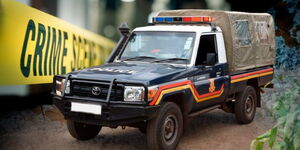Kenya is a country known for its diversity, with landmarks that cannot be found anywhere else in the world.
It is the only country in which you will find a National Park teeming with lions and a host of other wild animals, right in the middle of its capital city, Nairobi.
From dreamy tropical weather to white sandy beaches and lush plains, the country is arguably one of the most spectacular places to get lost in, with few coming close to its level of diversity.
Below is a list of 7 things that can only be described as uniquely Kenyan.
1. Kenya has 6 UNESCO World Heritage Sites
The East African nation boasts of 6 UNESCO world heritage sites namely: Fort Jesus, Mombasa, Kenya Lake System in the Great Rift Valley, Lake Turkana National Parks, Lamu Old Town, Mount Kenya National Park/Natural Forest, and the Sacred Mijikenda Kaya Forests.
The 6 are each unique in their own way, for example, The Kenya Lake System in the Great Rift Valley, comprises of three inter-linked relatively shallow lakes (Lake Bogoria, Lake Nakuru and Lake Elementaita) covering a total area of 32,034 hectares.
The sanctuary is home to 13 globally threatened bird species and some of the highest bird diversities in the world.
It is the single most important foraging site for the lesser flamingo anywhere, and a major nesting and breeding ground for great white pelicans.
Fort Jesus, on the other hand, was built by the Portuguese in 1593-1596 to the designs of Giovanni Battista Cairati to protect the port of Mombasa
2. Elizabeth became Queen while in Kenya
On January 3, 1952, the 25-year-old Princess Elizabeth and her new husband the Duke of Edinburgh set out on a journey to Kenya.
Upon touching down in Nairobi, the couple embarked on a 5-day safari through the Aberdare Ranges and opted to settle at Treetops Lodge in Nyeri.
Originally built in 1932, the Lodge lies in the path of an ancient Elephant migratory route between the Aberdare Ranges and Mt Kenya National park, and is strategically sited right in front of a natural watering hole and salt lick.
It was during her stay there that Princess Elizabeth's father, King George V, passed away in his sleep on February 5, 1952.
Uknown to her at the time, she was effectively the new Queen and Head of the Commonwealth. History records claim that her husband was the first to get the news and on February 6, 1952, at around 2:45 p.m. he informed his wife of the disheartening news after they had made their way to the renowned Sagana Lodge.
The Queen's coronation was celebrated with a road race through the Kenyan Bush, known as the "Coronation Rally".The race became an annual event, popularly known as the "Safari Rally".
Both historical landmarks are active and open to the public, 68 years later.
3. Paleolithic Remains in Turkana
The shores of Lake Turkana, located in the Northern edge Kenyan Rift Valley, has been a 'goldmine' for scientists over the years, with many describing it as the Cradle of Mankind.
The Koobi Fora site on the lake’s eastern shore, excavated by the Leakey family and other archeologists, remains the richest human fossil treasure trove found anywhere in the world.
In 1984, Kamoya Kimeu found a remarkably well-preserved skeleton of an 11- to 13-year-old boy “Turkana Boy” also known as Nariokotome Boy on the bank of the Nariokotome River near the lake. The fossil was dated to about 1.8 million years ago.
Other sites such as Lomekwi 3, discovered in a dry riverbed, hosted a collection of primitive hammers, anvils, and cutting tools that date back approximately 3.3 million years.
4. First Geothermal Power Plant in Africa
The mammoth project is situated within Hell's Gate National Park 120KM from Nairobi
Exploration for geothermal resources in Kenya started in the 1950s and gained momentum in the 1960s when two wells were drilled at Olkaria.
From 1967, the United Nations Development Programme (UNDP) in collaboration with the Kenyan Government and the then East African Power and Lighting Company Ltd., conducted geological and geophysical surveys in the area between Lake Bogoria and Olkaria.
The studies identified Olkaria as the most prospective area leading to the construction of the first geothermal power station between 1981 and 1984.
Kenya is currently the seventh-largest geothermal producer in the world.
Of the 12,328MW that has been developed worldwide, Kenya comprises 672MW, while the United States is number one at 3,442MW and the Philippines second at 1,904MW.
However, the country's geothermal potential in Kenya is estimated at 10,000MW.
5. MPESA
On March 7, 2007, Safaricom (Kenya's leading mobile service provider) launched a little-known mobile money transfer and micro-finance service.
The ease and convenience of sending money through one's phone took off like the wind and a year later, there were well over 2 million active subscribers.
Despite being replicated by several countries across various continents, the ingenious service's uptake in Kenya has not been matched.
According to data from the Safaricom website, by March 2017, there were 22.6 million subscribers actively using the mobile money platform.
It has since morphed into a way of life, with new additions such as the Lipa na MPESA service which enables one to operate without the hustle and risks associated with cash transactions.
6. Matatu culture
Kenya's colourful and loud matatus have left many in awe. From Grammy Award-winning American singer, songwriter and record producer Chris Brown, to Al Jazeera to the English Premier League.
Matatus dominate the public transport system of Kenya’s capital Nairobi as well as other cities such as Mombasa, and the catchier the level of artistry that goes into the creation of these vehicles, the better.
Dubbed by many as 'Clubs on wheels' or 'Museum on wheels', the Kenyan matatu culture is a vibrant scene filled with some amazing talent.
These museums on wheels comprise diverse designs featuring hip-hop artists, international pop stars, athletes, political icons and even religious leaders and actors from popular movies or TV series.
To paint a picture of how much love it takes to spruce up the vehicles, owners splash as much as Ksh150,000 for a paint job.
Each matatu is louder than the next, complete with graffiti-style artwork, custom designs, flashy lights and onboard entertainment to pull the crowds.
7. The Wildebeest Migration
Christened as one of the 8 wonders of the world, the phenomenon involves a mind-blowing two million animals making an 800 kilometre round trip between the Serengeti in Tanzania, and the Maasai Mara game reserve in Kenya.
Just to paint a picture, this is the single greatest movement of mammals in the world.
The vast herd crosses the Grumeti River in June/July and the Mara River between August and November, and it is at this time that some of the most spectacular photographs and video footage can be captured.
However, it is important to note that movement of the herds is completely dependent upon rainfall patterns.
Recent erratic weather patterns brought on by global warming are beginning to impact the migration patterns of Africa's wildlife.
Scientists say the change in length and timing of the rainy season is slowly reducing the amount of time wild animals spend in the Maasai Mara game reserve. As a result, the wildebeest which migrate there every year, make the return to Serengeti earlier than anticipated.
Capping it off is the legendary marathoner, Eliud Kipchoge. He is the only person who has ever walked the face to cover the marathon distance in less than two hours.
The entire nation held it's breath as he crossed the finish line on October 12, 2019, during that historic morning in Viena, Austria.
You can catch the legend doing his runs, in the lush Iten hill in Eldoret County, where other legendary athletes such as cycling phenom Chris Froom often visit for strength and conditioning.



